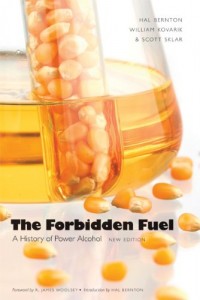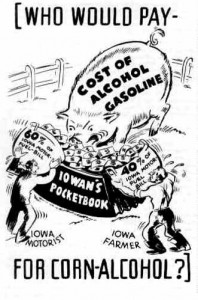 This week I read “The Forbidden Fuel: A History of Power Alcohol,” by authors Hal Bernton, William Kovarik and Scott Sklar. The book was originally published in 1982 and then republished in 2010 with a new Foreward added as well as a new Introduction added that gives the readers an update on where the ethanol industry is today. This book is absolutely the best history of alcohol fuel, aka ethanol, that I’ve ever read. But that being said, the reader must beware, that when reading the book, it was written in 1982 and the information and issues delivered were from that era. So when the authors discuss net energy, water use, etc., those facts and figures were the most up to date in 1982, not the most current in 2011.
This week I read “The Forbidden Fuel: A History of Power Alcohol,” by authors Hal Bernton, William Kovarik and Scott Sklar. The book was originally published in 1982 and then republished in 2010 with a new Foreward added as well as a new Introduction added that gives the readers an update on where the ethanol industry is today. This book is absolutely the best history of alcohol fuel, aka ethanol, that I’ve ever read. But that being said, the reader must beware, that when reading the book, it was written in 1982 and the information and issues delivered were from that era. So when the authors discuss net energy, water use, etc., those facts and figures were the most up to date in 1982, not the most current in 2011.
On that note, here is what I found most interesting about the information in the book. The same issues that the industry is fighting today, food versus fuel, indirect land use, net energy, and more, are the same issues that the industry was fighting 40 years ago. In fact, some of these issues date back more than 60 plus years ago. The petroleum industry has been using the same arguments against using ethanol in fuel since the 1930s. So what I find most disturbing is that the ethanol industry has not been able to successfully fight these issues in literally 80 years, and therefore the oil industry has had no need to change its game.
 The authors write that the first backlash from the oil industry came in 1933 when Iowa proposed a mandatory blending of ethyl alcohol in gasoline. The Iowa Petroleum Council printed a pamphlet headlined, “The alcohol-gas scheme outrages common sense.” The pamphlet warned that blending what today is known as E10 would constitute a raid on Iowa motorists’ pocketbooks. As the campaign progressed, the media began writing articles, perpetuated by the American Petroleum Institute (API) that “farmers would make motorists pay for farm relief.” In essence, with the debate going on today surrounding VEETC (the blender’s credit) and other ethanol incentives, the anti-ethanol movement is still attacking farmers and telling American drivers they are subsidizing American farmers.
The authors write that the first backlash from the oil industry came in 1933 when Iowa proposed a mandatory blending of ethyl alcohol in gasoline. The Iowa Petroleum Council printed a pamphlet headlined, “The alcohol-gas scheme outrages common sense.” The pamphlet warned that blending what today is known as E10 would constitute a raid on Iowa motorists’ pocketbooks. As the campaign progressed, the media began writing articles, perpetuated by the American Petroleum Institute (API) that “farmers would make motorists pay for farm relief.” In essence, with the debate going on today surrounding VEETC (the blender’s credit) and other ethanol incentives, the anti-ethanol movement is still attacking farmers and telling American drivers they are subsidizing American farmers.
Another interesting element of the book was to learn about the continual rise and falls of ethanol. With those rise and falls, the industry enthused optimism about how much fuel they would produce using what types of feedstocks. Researchers have had high hopes for aquaculture (kelp, algae, etc.) for more than 40 years. They have also been researching the potential for biomass. Needless to say, none of the optimism has come to fruition, but I do believe that now more than ever, the industry is truly on a breakthrough with advanced biofuels.
I believe that the industry needs to go back and read this book. Not for the science per say, but for the history of ethanol. The industry is fighting a very difficult battle and will learn a great deal from this book. If anything, you’ll take away what has worked and not worked in ethanol’s public communication battles.

